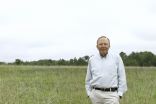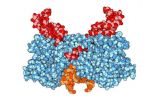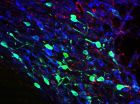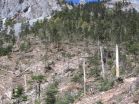Live longer? Save the planet? Better diet could nail both
New study shows healthier food choices could dramatically decrease environmental costs of agriculture
2014-11-12
(Press-News.org) As cities and incomes increase around the world, so does consumption of refined sugars, refined fats, oils and resource- and land-intense agricultural products such as beef. A new study led by University of Minnesota ecologist David Tilman shows how a shift away from this trajectory and toward healthier traditional Mediterranean, pescatarian or vegetarian diets could not only boost human lifespan and quality of life, but also slash greenhouse gas emissions and save habitat for endangered species.
The study, published in the November 12 online edition of Nature by Tilman and graduate student Michael Clark, synthesized data on environmental costs of food production, diet trends, relationships between diet and health, and population growth. Their integrated analysis painted a striking picture of the human and environmental health costs of our current diet trajectory as well as how strategically modifying food choices could reduce not only incidence of type II diabetes, coronary heart disease and other chronic diseases, but global agricultural greenhouse gas emissions and habitat degradation as well.
"We showed that the same dietary changes that can add about a decade to our lives can also prevent massive environmental damage," said Tilman, a professor in the University's College of Biological Sciences and resident fellow at the Institute on the Environment. "In particular, if the world were to adopt variations on three common diets, health would be greatly increased at the same time global greenhouse gas emissions were reduced by an amount equal to the current greenhouse gas emissions of al all cars, trucks, plans trains and ships. In addition, this dietary shift would prevent the destruction of an area of tropical forests and savannas as large as half of the United States."
The researchers found that, as incomes increased between 1961 and 2009, people consumed more meat protein, empty calories and total calories per person. When these trends were combined with forecasts of population growth and income growth for the coming decades, the study predicted that diets in 2050 would contain fewer servings of fruits and vegetables, but about 60 percent more empty calories and 25 to 50 percent more pork, poultry, beef, dairy and eggs -- a suite of changes that would increase of type II diabetes, coronary heart disease and some cancers. Using life-cycle analyses of various food production systems, the study also calculated that, if current trends prevail, these 2050 diets would also lead to an 80 percent increase in global greenhouse gas emissions from food production as well as habitat destruction due to land clearing for agriculture around the world.
The study then compared health impacts of the global omnivorous diet with those reported for traditional Mediterranean, pescatarian and vegetarian diets. Adopting these alternative diets could reduce incidence of type II diabetes by about 25 percent, cancer by about 10 percent and death from heart disease by about 20 percent relative to the omnivore diet. Additionally, the adoption of these or similar alternative diets would prevent most or all of the increased greenhouse gas emissions and habitat destruction that would otherwise be caused by both dietary changes and increased global population.
The authors acknowledged that numerous factors go into diet choice -- but also pointed out that the alternative diets already are part of the lives of countless people around the world. Noting that variations on the diets used in the scenario could potentially show even greater benefit, they concluded that "the evaluation and implementation of dietary solutions to the tightly linked diet-environment-health trilemma is a global challenge, and opportunity, of great environmental and public health importance."
INFORMATION:
Tilman is a Regents Professor and McKnight Presidential Chair in Ecology in the College of Biological Sciences' Department of Ecology, Evolution and Behavior and a resident fellow in the University of Minnesota's Institute on the Environment, which seeks lasting solutions to Earth's biggest challenges through research, partnerships and leadership development. Clark is currently a doctoral student in the College of Food, Agricultural and Natural Resource Sciences.
[Attachments] See images for this press release:

ELSE PRESS RELEASES FROM THIS DATE:
2014-11-12
Menlo Park, Calif. -- A study at the Department of Energy's SLAC National Accelerator Laboratory suggests for the first time how scientists might deliberately engineer superconductors that work at higher temperatures.
In their report, a team led by SLAC and Stanford University researchers explains why a thin layer of iron selenide superconducts -- carries electricity with 100 percent efficiency -- at much higher temperatures when placed atop another material, which is called STO for its main ingredients strontium, titanium and oxygen.
These findings, described today ...
2014-11-12
Graphene is the miracle material of the future. Consisting of a single layer of carbon atoms arranged in a honeycomb lattice, the material is extremely stable, flexible, highly conductive and of particular interest for electronic applications. ETH Professor Tilman Esslinger and his group at the Institute for Quantum Electronics investigate artificial graphene; its honeycomb structure consists not of atoms, but rather of light. The researchers align multiple laser beams in such a way that they create standing waves with a hexagonal pattern. This optical lattice is then superimposed ...
2014-11-12
A research team led by Jackson Laboratory Professors Frank McKeon, Ph.D., and Wa Xian, Ph.D., reports on the role of certain lung stem cells in regenerating lungs damaged by disease.
The work, published Nov. 12 in the journal Nature, sheds light on the inner workings of the still-emerging concept of lung regeneration and points to potential therapeutic strategies that harness these lung stem cells.
"The idea that the lung can regenerate has been slow to take hold in the biomedical research community," McKeon says, "in part because of the steady decline that is seen ...
2014-11-12
The brain's ability to effectively deal with stress or to lack that ability and be more susceptible to depression, depends on a single protein type in each person's brain, according to a study conducted at the Icahn School of Medicine at Mount Sinai and published November 12 in the journal Nature.
The Mount Sinai study findings challenge the current thinking about depression and the drugs currently used to treat the disorder.
"Our findings are distinct from serotonin and other neurotransmitters previously implicated in depression or resilience against it," says the ...
2014-11-12
Not long ago, it would have taken several years to run a high-resolution simulation on a global climate model. But using some of the most powerful supercomputers now available, Lawrence Berkeley National Laboratory (Berkeley Lab) climate scientist Michael Wehner was able to complete a run in just three months.
What he found was that not only were the simulations much closer to actual observations, but the high-resolution models were far better at reproducing intense storms, such as hurricanes and cyclones. The study, "The effect of horizontal resolution on simulation ...
2014-11-12
The human immunodeficiency virus (HIV) can insert itself at different locations in the DNA of its human host - and this specific integration site determines how quickly the disease progresses, report researchers at KU Leuven's Laboratory for Molecular Virology and Gene Therapy. The study was published online today in the journal Cell Host & Microbe.
When HIV enters the bloodstream, virus particles bind to and invade human immune cells. HIV then reprogrammes the hijacked cell to make new HIV particles.
The HIV protein integrase plays a key role in this process: it ...
2014-11-12
Details of the role of glutamate, the brain's excitatory chemical, in a drug reward pathway have been identified for the first time.
This discovery in rodents - published today in Nature Communications - shows that stimulation of glutamate neurons in a specific brain region (the dorsal raphe nucleus) leads to activation of dopamine-containing neurons in the brain's reward circuit (dopamine reward system).
Dopamine is a neurotransmitter present in regions of the brain that regulate movement, emotion, motivation, and feelings of pleasure. Glutamate is a neurotransmitter ...
2014-11-12
HANOVER, N.H. - China's anti-logging, conservation and ecotourism policies are accelerating the loss of old-growth forests in one of the world's most ecologically fragile places, according to studies led by a Dartmouth College scientist.
The findings shed new light on the complex interactions between China's development and conservation policies and their impact on the most diverse temperate forests in the world, in "Shangri-La" in northwest Yunnan Province. Shangri-La, until recently an isolated Himalayan hinterland, is now the epicenter of China's struggle to wed sustainable ...
2014-11-12
The "surfactant" chemicals found in samples of fracking fluid collected in five states were no more toxic than substances commonly found in homes, according to a first-of-its-kind analysis by researchers at the University of Colorado Boulder.
Fracking fluid is largely comprised of water and sand, but oil and gas companies also add a variety of other chemicals, including anti-bacterial agents, corrosion inhibitors and surfactants. Surfactants reduce the surface tension between water and oil, allowing for more oil to be extracted from porous rock underground.
In a new ...
2014-11-12
Action movies may drive box office revenues, but dramas and deeper, more serious movies earn audience acclaim and appreciation, according to a team of researchers.
"Most people think that entertainment is just a silly diversion, but our research shows that entertainment is profoundly meaningful and moving for many people," said Mary Beth Oliver, Distinguished Professor in Media Studies and co-director of Media Effects Research Laboratory, Penn State. "It's not just types of entertainment that we usually think of as meaningful, such as poetry and dance, either, but also ...
LAST 30 PRESS RELEASES:
[Press-News.org] Live longer? Save the planet? Better diet could nail both
New study shows healthier food choices could dramatically decrease environmental costs of agriculture




